The Economics and Statistics Division maintains archives of previous publications for accountability purposes, but makes no updates to keep these documents current with the latest data revisions from Statistics Canada. As a result, information in older documents may not be accurate. Please exercise caution when referring to older documents. For the latest information and historical data, please contact the individual listed to the right.
<--- Return to Archive
For additional information relating to this article, please contact:
October 19, 2017EMPLOYMENT INSURANCE, AUGUST 2017 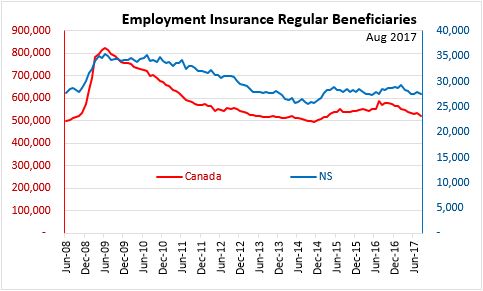
In August 2017, the number (seasonally adjusted) of Nova Scotians receiving regular Employment Insurance (EI) benefits decreased by 330 persons (1.2 per cent) from the previous month to 27,600 and decreased by 840 persons (3.0 per cent) over August 2016.
In August 2017, the number (seasonally adjusted) of Canadians receiving regular EI benefits decreased 1.8 per cent (9,550 persons) from the previous month to 524,150. The number of regular EI beneficiaries decreased by 45,570 (-8.0 per cent) over August 2016.
The number (seasonally adjusted) of Nova Scotians receiving regular EI benefits in August 2017 accounted for 5.7 per cent of the total labour force. In Canada, the number of EI beneficiaries accounted for 2.7 per cent of the total labour force.
Following a slow but steady increase through much of 2016, the number of EI beneficiaries in Nova Scotia had been generally declining until the middle of 2017 and has been relatively flat since. Looking at the longer-term, the number of beneficiaries has been relatively steady since 2015.
AGE
The majority (61.8 per cent) of regular EI recipients in Nova Scotia were in the 25 to 54 age group, who make up 62.3 per cent of the labour force. Although they account for 23.4 per cent of the labour force, 27.8 per cent of EI recipients were in the 55 years and over age group. A further 10.3 per cent of EI recipients were in the 15 to 24 age group, though they are 14.4 per cent of the labour force and 31.9 per cent of the unemployed.
For people aged 55 years and over, EI beneficiaries accounted for 6.7 per cent of the labour force in the same age range. For the labour force between the ages of 25 and 54, EI beneficiaries accounted for 5.6 per cent of the total and for ages 15 to 24, they accounted for 4.1 per cent.
On a year-over-year basis, the number of beneficiaries in the 15 to 24 age group increased by 10 persons, the 25-54 age group decreased by 200 persons, and the 55 years and over group decreased by 150 persons.
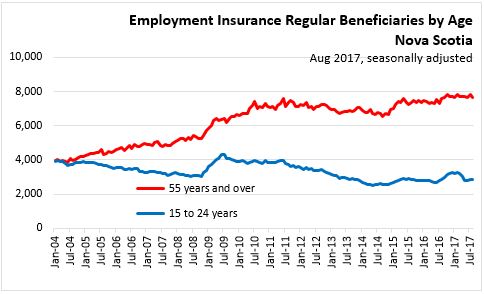
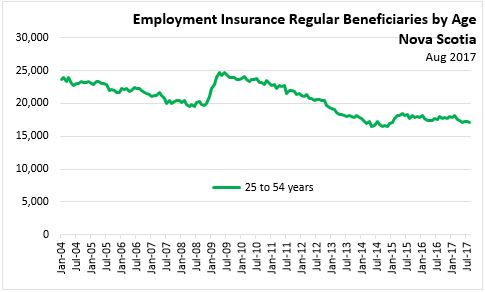
COUNTIES
In August 2017, six counties reported higher regular EI beneficiaries compared to a year ago while eleven counties showed a decrease and one was unchanged.
In the first eight months of 2017, fifteen counties reported an increase in regular EI beneficiaries compared to the same period in 2016, including Halifax and Cape Breton. Three counties reported a decrease.
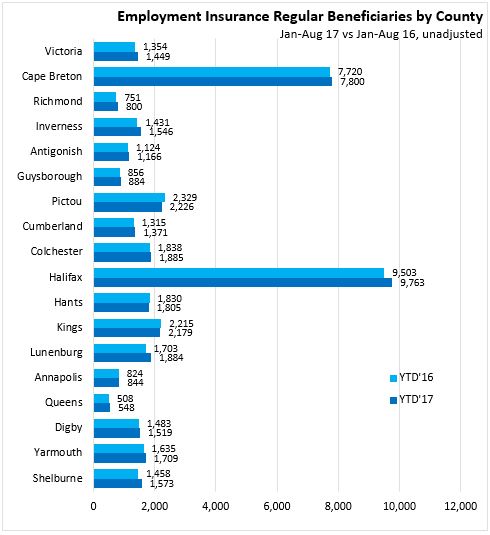
OCCUPATION
In Nova Scotia in August 2017, the highest number of EI recipients were last employed in the trades, transport and equipment operators occupations (8,520, or 30.9 per cent of the monthly total), followed by sales and service occupations (4,810 or 17.4 per cent of the total) and natural resources, agriculture and related occupations (3,970, or 14.4 per cent of the total).
Comparing the first eight months of 2017 to the same period in 2016, the largest percentage increase in EI beneficiaries was among recipients last employed in art, culture, recreation and sport, while the largest increase in absolute terms was among recipients last employed in sales and services occupations. In percentage terms, the number of EI beneficiaries declined the most over this period for recipients that were last employed in natural and applied sciences and trades, transport and equipment operators. In absolute terms the largest decrease was in natural and applied sciences.
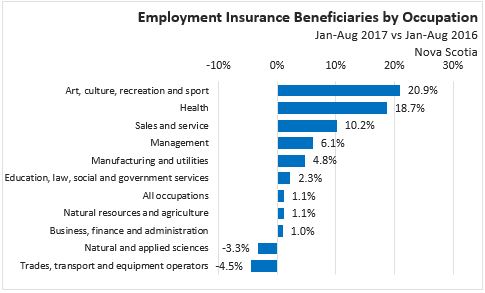
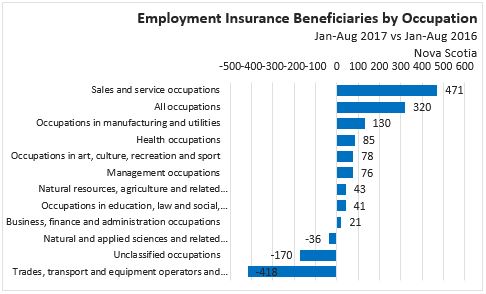
YEAR TO DATE - PROVINCES
Across the country, five provinces saw year to date increases in EI beneficiaries. Saskatchewan and Prince Edward Island (both +8.2 per cent) led provinces in year to date EI beneficiary growth. Quebec (-8.0 per cent), Alberta (-3.6 per cent) and Ontario (-3.5 per cent), led the declines in the number of EI beneficiaries. The average across Canada was a 3.0% decrease in annual average EI beneficiaries.
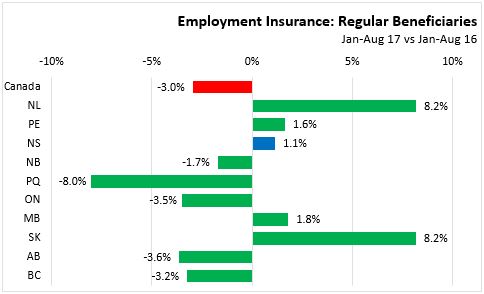
EI BENEFICIARIES AS A SHARE OF THE UNEMPLOYED BY PROVINCE
In Nova Scotia, EI beneficiaries accounted for 63.9 per cent of the unemployed in August 2017, compared to a Canadian rate of 42.7 per cent. Across the country, EI beneficiaries accounted for the highest shares of the unemployed in the Atlantic provinces, led by Newfoundland and Labrador, New Brunswick and Prince Edward Island. EI beneficiaries accounted for the lowest shares in Ontario, followed by Alberta and British Columbia.
Note that due to differences in estimation methodology, it is possible for the reported number of EI beneficiaries to exceed the reported number of unemployed in a given jurisdiction.
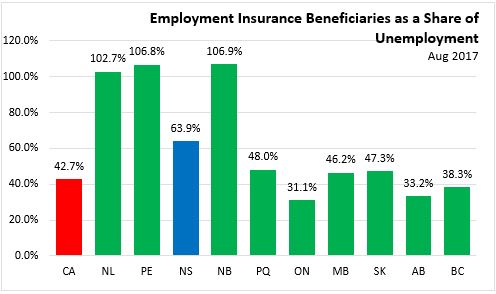
Legislative changes to the EI program came into effect in July 2016. While some of these changes affected all EI regions across Canada, eligible claimants in the 15 regions that posted notable increases in unemployment received additional weeks of regular benefits starting in July. More information on the 2016 EI changes is available on Employment and Social Development Canada's (ESDC) website. As a result of the changes to the EI program, historical comparisons are not recommended, except in areas outside of the 15 EI regions where eligible claimants received additional weeks of benefits. These 15 EI regions are Newfoundland and Labrador, Northern Ontario, Sudbury, Northern Manitoba, Southern Saskatchewan, Northern Saskatchewan, Saskatoon, Southern Alberta, Northern Alberta, Calgary, Edmonton, Southern Interior British Columbia, Northern British Columbia, Whitehorse and Nunavut.
Statistics Canada CANSIM 276-0022 (Age, Province), 276-0043 (Occupation), 276-0035 (County level)
<--- Return to Archive